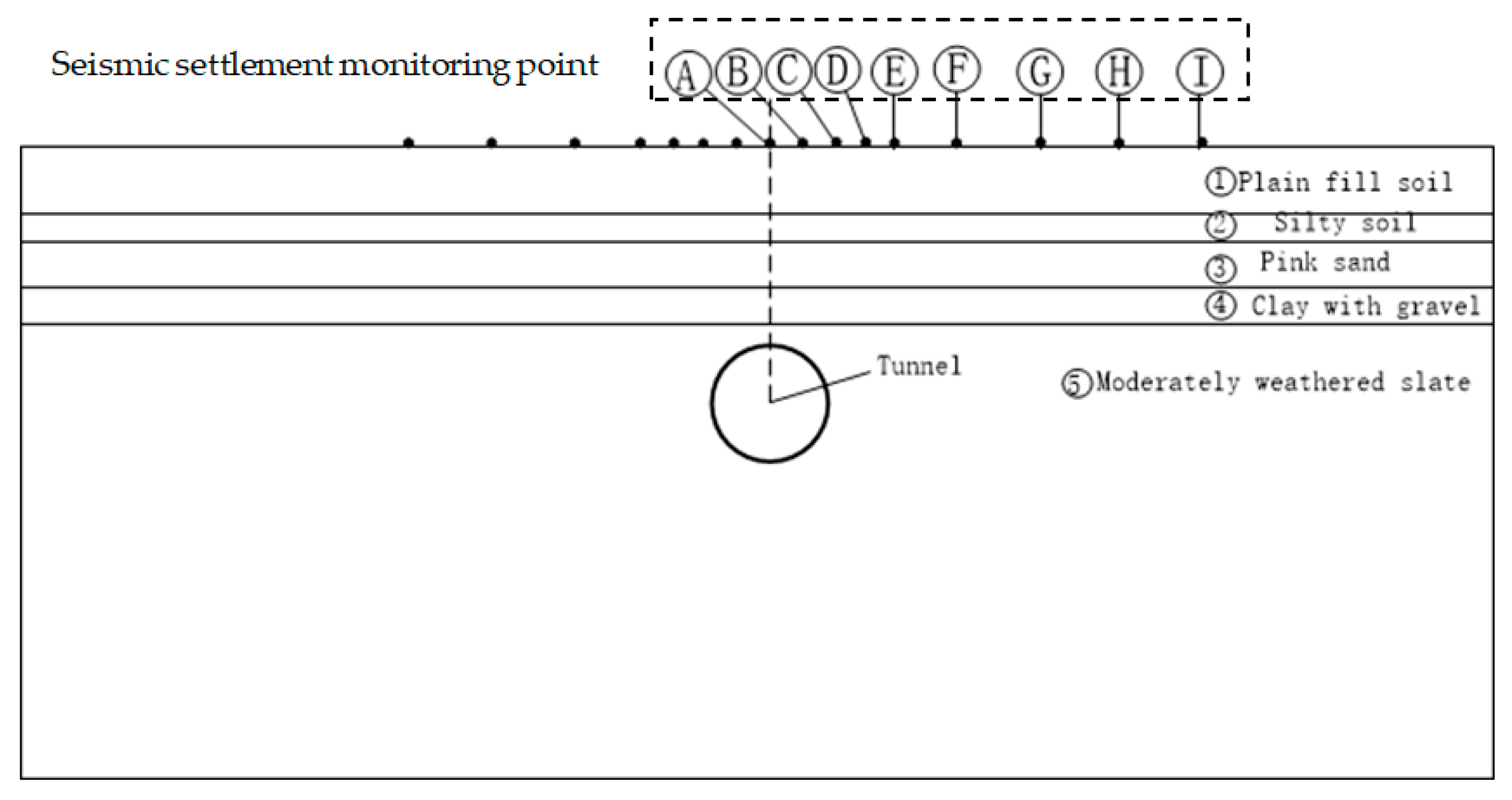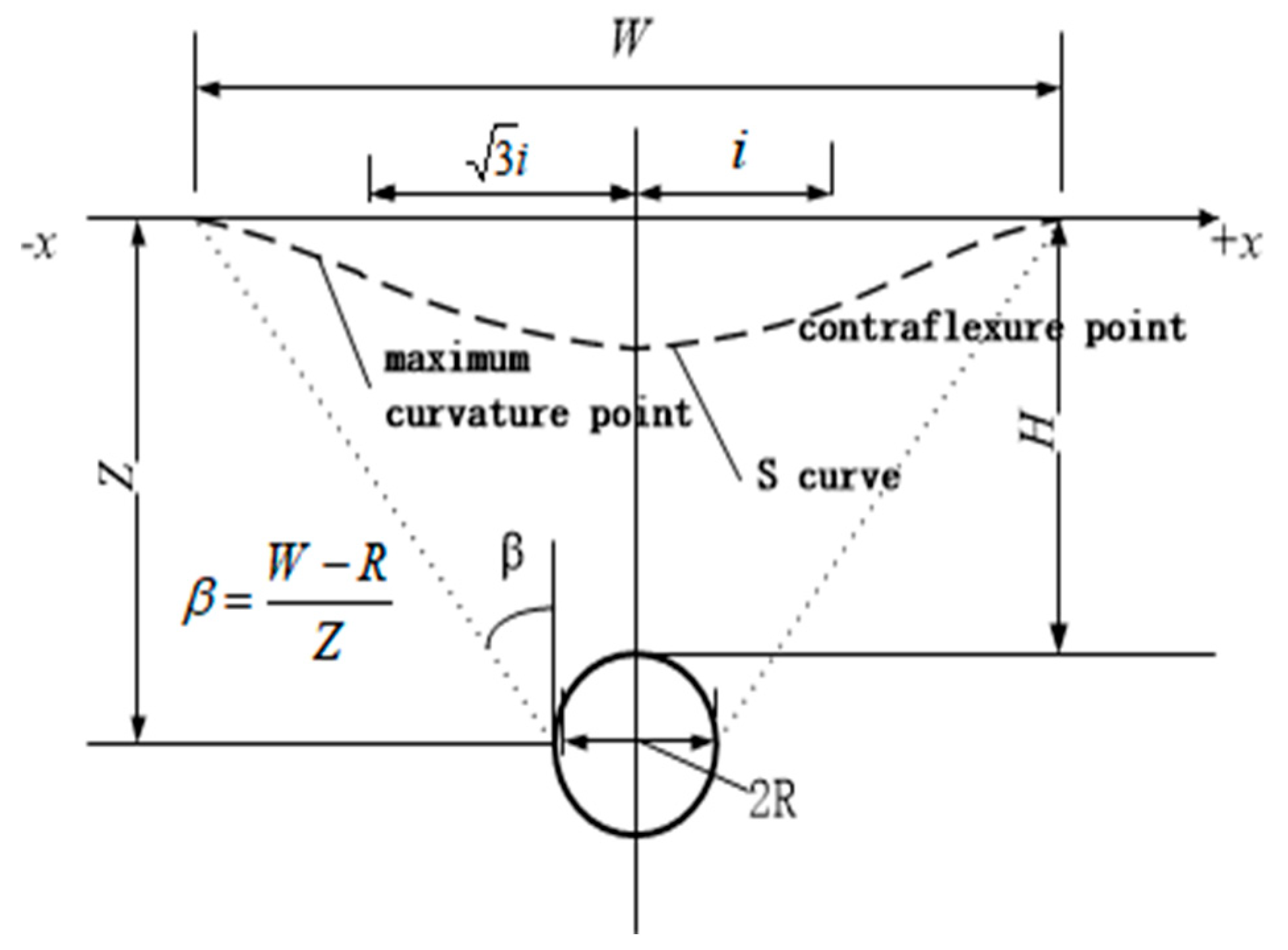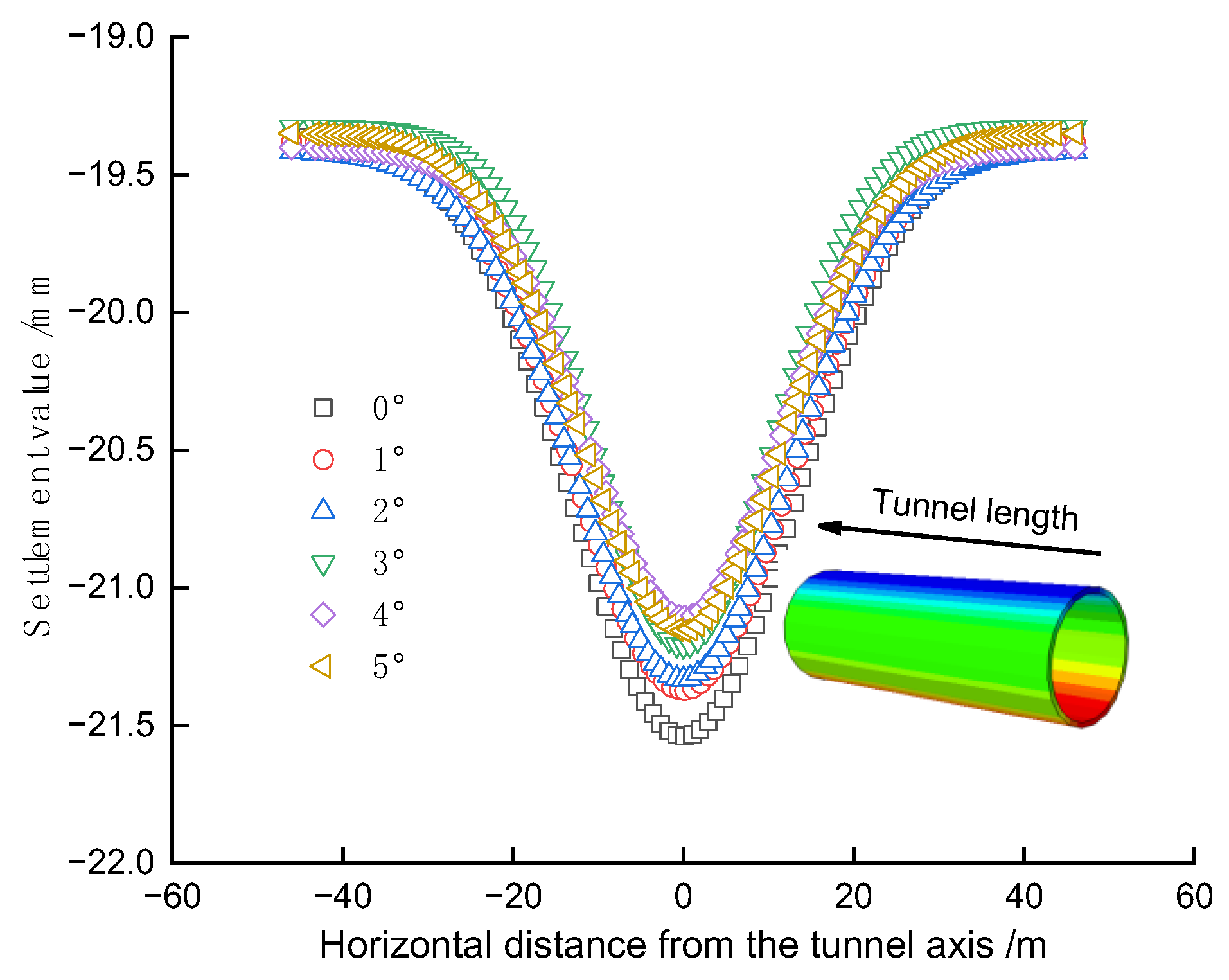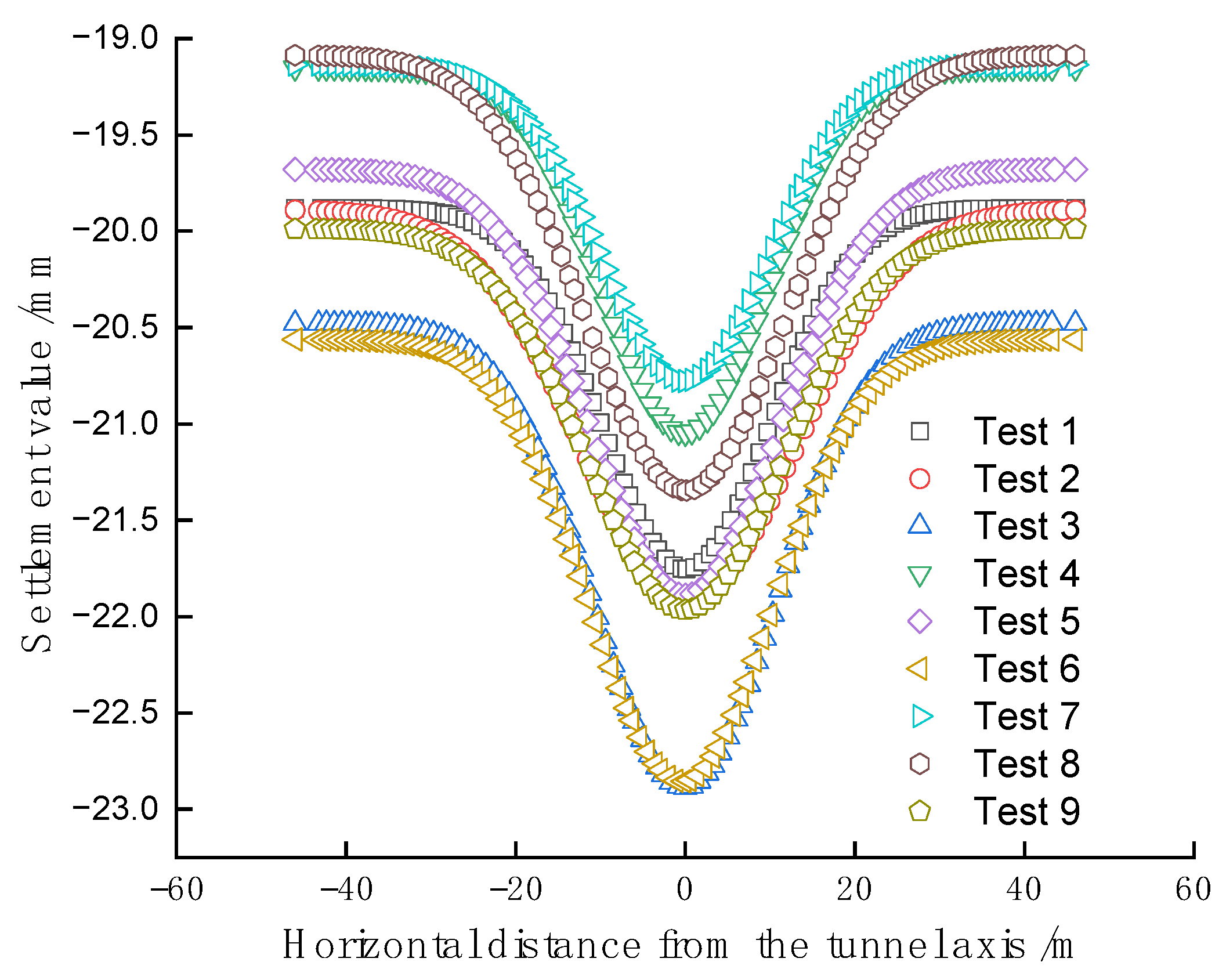Study on the Surface Settlement of an Overlying Soft Soil Layer under the Action of an Earthquake at a Subway Tunnel Engineering Site
Abstract
:1. Introduction
2. Numerical Model of the Metro Tunnel with an Overlying Soft Soil Layer
2.1. Convergence–Confinement Method Based on Elastic–Plastic Analysis
2.2. Calculation of Geometric Dimensions and Parameters of the Model
2.3. Model Materials and Boundary Conditions
2.4. Selection of Seismic Loads
3. Results and Discussion
3.1. Settlement Deformation Law of the Tunnel Roof Strata
3.2. Analysis of Ground Settlement Theory
4. Analysis of the Impact of Soft Soil Parameters on Ground Settlement at the Top of the Tunnel
4.1. The Impact of Elastic Modulus on Ground Settlement at the Top of the Tunnel
4.2. The Impact of Cohesion on Ground Settlement at the Top of the Tunnel
4.3. The Impact of Poisson’s Ratio on Ground Settlement at the Top of the Tunnel
4.4. The Impact of Internal Friction Angle on Ground Settlement at the Top of the Tunnel
4.5. The Impact of Various Factors on Ground Maximum Settlement at the Top of the Tunnel
5. Orthogonal Experiment
5.1. Orthogonal Experimental Design
5.2. Orthogonal Experimental Results
5.3. Sensitivity Analysis
6. Conclusions
- (1)
- The settlement within a certain range above the tunnel is significantly greater than the surrounding layers. The maximum width of the settlement trough occurred under the influence of the El-Centro wave, followed by the synthetic artificial earthquake wave with a 10% exceedance probability, and the minimum width of the settlement trough occurred under the influence of the Kobe wave.
- (2)
- Within a range of about 20 m of the tunnel’s top surface, the seismic and special rock–soil layers of the overlying soft soil have the strongest impact on the surface settlement, and the settlement law of the overlying strata conforms to Peck’s formula.
- (3)
- The surface settlement above the tunnel is negatively correlated with the elastic modulus and cohesion of silty clay, is positively correlated with the Poisson’s ratio, and is essentially unaffected by the internal friction angle.
- (4)
- The sensitivity of soft soil parameters to the settlement of the tunnel’s top surface under earthquake loading is in the order of the Poisson’s ratio, the elastic modulus, the cohesive force, and the internal friction angle. The research findings of this paper provide scientific support for earthquake-resistance and disaster-reduction measures for underground metro tunnel engineering sites with overlying soft soil layers which are both sustainable and practical. However, due to limitations of space, the indoor vibration table test could not be further explored in relation to this engineering background. This study has significant theoretical and practical significance in the field of sustainability.
Author Contributions
Funding
Institutional Review Board Statement
Informed Consent Statement
Data Availability Statement
Conflicts of Interest
References
- Jin, H.; Yuan, D.J.; Zhou, S.X.; Zhao, D. Short-Term and Long-Term Displacement of Surface and Shield Tunnel in Soft Soil: Field Observations and Numerical Modeling. Appl. Sci. 2022, 12, 3564. [Google Scholar] [CrossRef]
- Tsinidis, G. Response characteristics of rectangular tunnels in soft soil subjected to transversal ground shaking. Tunn. Undergr. Space Technol. 2017, 62, 1–22. [Google Scholar] [CrossRef]
- Shahidi, A.R.; Vafaeian, M. Analysis of longitudinal profile of the tunnels in the active faulted zone and designing the flexible lining (for Koohrang-III tunnel). Tunn. Undergr. Space Technol. 2005, 20, 213–221. [Google Scholar] [CrossRef]
- Oreste, P.P. The importance of longitudinal stress effects on the static conditions of the final lining of a tunnel. Tunn. Undergr. Space Technol. 2002, 17, 21–32. [Google Scholar] [CrossRef]
- Takada, S.; Hassani, N.; Fukuda, K. A new proposal for simplified design of buried steel pipes crossing active faults. Earthq. Eng. Struct. Dyn. 2001, 30, 1243–1257. [Google Scholar] [CrossRef]
- Hashash, Y.M.A.; Tseng, W.S.; Krimotat, A. Seismic soil-structure interaction analysis for immersed tube tunnels retrofit. Geotech. Spec. Publ. 1998, 75, 1380–1391. [Google Scholar] [CrossRef]
- Li, J.; Li, G.Q. Introduction to Seismic Engineering; Earthquake Publishing House: Beijing, China, 1992. [Google Scholar]
- Xu, Y. Finite Element and Infinite Element Coupling Analysis Method for Soil-Underground Tunnel Structure System under Seismic Effects; Tianjin University: Tianjin, China, 1999. [Google Scholar]
- Fang, M.; Zhou, C.Y.; Liu, Z. Effect of crossing tunnel shield construction parameters and crossing Angle on the settlement of existing tunnels. Eng. Mech. 2011, 28, 133–138. [Google Scholar]
- Zhang, J.H.; Wang, H.W.; Chen, P.X.; Xu, F.; Wu, J. Analysis of direct cutting pile settlement under shield tunneling of Hangzhou Metro Line 4. Eng. Mech. 2022, 39, 144–152. [Google Scholar]
- Moore, I.D.; Guan, F. Three-Dimensional Dynamic Response of Lined Tunnels due to Incident Seismic Waves. Earthq. Eng. Struct. Dyn. 1996, 25, 357–369. [Google Scholar] [CrossRef]
- Chakeri, H.; Ozcelik, Y.; Unver, B. Investigation of ground surface settlement in twin tunnels driven with EPBM in urban area. Arab. J. Geosci. 2015, 8, 7655–7666. [Google Scholar] [CrossRef]
- Yang, C.; Yang, L.D.; Ji, Q.Q. Study on Numerical Calculation of Earthquake Response in Soft Land Railway Station. J. Undergr. Space Eng. 2006, 2, 87–91+95. [Google Scholar]
- Patil, M.; Choudhury, D.; Ranjith, P.G.; Zhao, J. Behavior of shallow tunnel in soft soil under seismic conditions. Tunn. Undergr. Space Technol. Inc. Trenchless Technol. Res. 2018, 75, 30–38. [Google Scholar] [CrossRef]
- Samanta, A.; Pandey, P. Effects of ground motion modification methods and ground motion duration on seismic performance of a 15-storied building. J. Build. Eng. 2018, 15, 14–25. [Google Scholar] [CrossRef]
- Xia, F.; Guo, B.Z.; Yu, D.X. Effect of dynamic parameters of thick silty clay on surface seismic parameters. Earthq. Eng. J. 2016, 38, 391–397. [Google Scholar]
- Zuo, X.; Chen, G.X.; Wang, Z.H.; Du, X.L.; Hong, X.X.; Li, F.M. Vibration platform test of the near and far field seismic response characteristics of the subway station structure on the weak site. J. Civ. Eng. 2010, 43, 299–305. [Google Scholar]
- Liu, G. Study on the Stability of Structural Rheological Surrounding Rock in High Stress Zones; Chengdu University of Technology: Chengdu, China, 2002. [Google Scholar]
- Xia, Y.X.; Wang, W.Z.; Hu, Q.A. Effect of Round Rock Stress Release Rate on Construction of Double Arch Tunnel. Mod. Tunn. Technol. 2005, 3, 1–4. [Google Scholar]
- Wang, G.C.; Ma, D.J.; Yang, Y.; Zhang, J. Three-dimensional finite element analysis of surface subsidence caused by subway shield construction in soft land layer. Geotech. Eng. J. 2011, 33, 273–277. [Google Scholar]
- General Administration of Quality Supervision; Inspection and Quarantine of the People’s Republic of China; Standardization Administration of China. GB 18306-2015 Seismic Ground Motion Parameters Zonation Map of China; China Standards Press: Beijing, China, 2015. [Google Scholar]
- Peck, R.B. Deep excavation and tunnelling in soft ground, State of the art volume. In Proceedings of the 7th ICSMFE, Mexico City, Mexico, 1969; Volume 4, pp. 225–290. [Google Scholar]
- Zhou, Y.; Zhu, Y. Study on dynamic stability of grillage flexible slope supporting structure with pre-stressed anchors under rainfall infiltration. In Proceedings of the International Conference on Electric Technology and Civil Engineering (ICETCE), Lushan, China, 22–24 April 2011; pp. 2616–2620. [Google Scholar]
- Sun, H.X.; Zhang, K.; Chen, S.L. Numerical simulation of foundation pit deformation considering the influence of precipitation and distribution of excavation. J. Shenyang Univ. Technol. 2014, 36, 711–715. [Google Scholar]
- Zhu, H.B.; Xi, K.Q. Orthogonal trial design and data analysis in SPSS 17.0. J. Cap. Sport. Coll. 2013, 25, 283–288. [Google Scholar]
















| Stratigraphic (Genetic) | Layer Thickness/m | Density /kg·m−3 | Elasticity Modulus E/MPa | Cohesion c/KPa | Internal Friction angle φ/° | Poisson’s Ratio ν |
|---|---|---|---|---|---|---|
| ① Plain fill soil | 5.8 | 1850 | 60 | 12 | 10 | 0.38 |
| ② Silty soil | 1.7 | 1800 | 30 | 15 | 3 | 0.42 |
| ③ Pink sand | 3.2 | 1900 | 200 | 5 | 29.2 | 0.20 |
| ④ Clay with gravel | 2.5 | 1950 | 280 | 30 | 25 | 0.25 |
| ⑤ Moderately weathered slate | 51.2 | 2500 | 5000 | 50 | 40 | 0.15 |
| Density/kg·m−3 | Thickness/m | Elasticity Modulus E/Mpa | Poisson’s Ratio v |
|---|---|---|---|
| 2450 | 0.3 | 36,500 | 0.23 |
| Factor | A Elastic Modulus E/MPa | B Poisson’s Ratio ν | C Cohesion c/kPa | |
|---|---|---|---|---|
| Level | ||||
| 1 | 30 | 0.42 | 10 | |
| 2 | 35 | 0.4 | 15 | |
| 3 | 40 | 0.38 | 20 | |
| Test Number | A | B | C |
|---|---|---|---|
| 1 | 1 | 1 | 1 |
| 2 | 1 | 2 | 2 |
| 3 | 1 | 3 | 3 |
| 4 | 2 | 1 | 2 |
| 5 | 2 | 2 | 3 |
| 6 | 2 | 3 | 1 |
| 7 | 3 | 1 | 3 |
| 8 | 3 | 2 | 1 |
| 9 | 3 | 3 | 2 |
| Test Number | Maximum Settlement/mm | ||
|---|---|---|---|
| A | B | C | |
| K1 | 66.26 | 63.4 | 65.61 |
| K2 | 65.47 | 64.84 | 64.73 |
| K3 | 63.96 | 67.45 | 65.35 |
| k1 | 22.087 | 21.33 | 21.87 |
| k2 | 21.823 | 21.613 | 21.577 |
| k3 | 21.32 | 22.483 | 21.783 |
| Rj | 0.767 | 1.153 | 0.223 |
Disclaimer/Publisher’s Note: The statements, opinions and data contained in all publications are solely those of the individual author(s) and contributor(s) and not of MDPI and/or the editor(s). MDPI and/or the editor(s) disclaim responsibility for any injury to people or property resulting from any ideas, methods, instructions or products referred to in the content. |
© 2023 by the authors. Licensee MDPI, Basel, Switzerland. This article is an open access article distributed under the terms and conditions of the Creative Commons Attribution (CC BY) license (https://creativecommons.org/licenses/by/4.0/).
Share and Cite
Wang, Q.; Zou, L.; Niu, Y.; Ma, F.; Lu, S.; Fu, Z. Study on the Surface Settlement of an Overlying Soft Soil Layer under the Action of an Earthquake at a Subway Tunnel Engineering Site. Sustainability 2023, 15, 9484. https://doi.org/10.3390/su15129484
Wang Q, Zou L, Niu Y, Ma F, Lu S, Fu Z. Study on the Surface Settlement of an Overlying Soft Soil Layer under the Action of an Earthquake at a Subway Tunnel Engineering Site. Sustainability. 2023; 15(12):9484. https://doi.org/10.3390/su15129484
Chicago/Turabian StyleWang, Qiongyi, Liang Zou, Yungang Niu, Fenghai Ma, Shasha Lu, and Zhideyi Fu. 2023. "Study on the Surface Settlement of an Overlying Soft Soil Layer under the Action of an Earthquake at a Subway Tunnel Engineering Site" Sustainability 15, no. 12: 9484. https://doi.org/10.3390/su15129484
APA StyleWang, Q., Zou, L., Niu, Y., Ma, F., Lu, S., & Fu, Z. (2023). Study on the Surface Settlement of an Overlying Soft Soil Layer under the Action of an Earthquake at a Subway Tunnel Engineering Site. Sustainability, 15(12), 9484. https://doi.org/10.3390/su15129484






